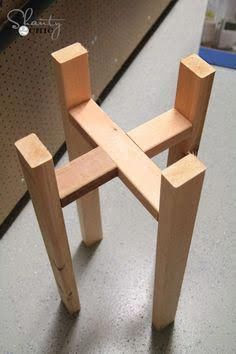Introduction
Woodworking is an ancient art form which involves the manipulation of wood to build or create functional or decorative objects, either through hand tools or powered tools. It encompasses a variety of different jobs that can involve making furniture, cabinets, sculpture, musical instruments, and other objects. Jobs related to woodworking are generally divided into two categories: carpentry and joinery.
Carpentry professionals specialize in construction and installation tasks and typically require more advanced technical skills. They might be responsible for constructing walls in new buildings, assembling and installing doors and windows, remodeling existing homes by adding features like decks or sheds and may also have expertise in engineering principles such as structural integrity or building codes.
Joinery is the practice of fitting and connecting pieces of wood without using nails, screws or other fasteners. Joiners use jointing techniques such as mortise-and-tenon joints, dovetail joints and dowel joints to construct projects like furniture frames, cabinets and even larger items like boats. Many joiners specialize in unique custom work involving intricate designs. Other job functions within this profession include creating tables, doing repairs on furniture pieces as well as sculpting figurines from blocks of wood. Woodworkers who master these skills often open up their own shops where they craft custom works for customers from all over the country who desire something unique for their homes
Tools and Techniques
Tools and techniques used in woodworking projects typically include saws, hammers, screwdrivers, chisels, augers, dowels, braces, levels, clamps, planes, drills and routers. Hand tools such as carving knives are also often used. Power tools such as electric drills and saws are becoming increasingly popular with woodworkers. Specialized power tools like band saws, drill presses and jointers can be used to efficiently complete projects. Depending on the project being undertaken there may also be need for additional power tools such as belt sanders or thickness planers to work with different types of woods more effectively. Safety equipment including goggles, earmuffs and gloves should always be worn when using power tools as they can cause serious injury if not treated with precaution.
Types of Woodworking Projects
Furniture Making: Furniture making is a popular type of woodworking project that involves creating pieces of furniture from raw materials like wood and metal. This could involve designing and constructing entire pieces or repairing and refinishing existing ones. Skills needed for furniture making include knowledge of material properties, woodworking tools, machines and techniques.
Joinery: Joinery is one type of woodworking project that focuses mainly on cutting precise angles and joining them together. This could involve constructing door frames, cabinets and stairs out of pieces of wood or fabricating intricate designs. Joinery requires precision, accuracy and the ability to measure accurately with the help of a number of different measurement tools.
Cabinets: Another type of woodworking project is cabinet-making which involves producing carefully crafted wooden cabinets for homes or businesses. These cabinets can be custom-made to fit any space perfectly. Skills required in this field include accurate measuring skills (like joinery), an understanding of cabinet design/construction techniques and the know-how to work with a variety of materials including veneers, solid woods, laminates, screen doors etc.
Carpentry: Carpentry is a more general term used when referring to projects involving building structures with the use of lumber, plywood, paneling etc.. Examples include erecting walls or building decks/porches as well as various other indoor/outdoor construction tasks. Carpenters must be familiar with tools such as saws, hammers and drills in order to complete these projects successfully.
Design Elements
A job in woodworking can be anything from a furniture designer to a carpenter. One job that involves elements of design is color and material selection. This requires knowledge of how color affects the visual impact of a given design, along with an understanding of the aesthetics of different materials and how they interact with each other.
Another aspect to consider when choosing materials for a project is proportion and scale. A successful design needs to balance its components so that each element complements the overall look and feel; this means appropriately scaling each feature or piece in order to make it aesthetically pleasing. It’s important for somebody who works in woodworking to stay on top of current trends in materials, finishes, colors, textures, etc., as well as current technologies (if applicable). Having proficiency in computer aided design (such as Autocad) also helps if you’re aiming to create designs yourself.
Educational Requirements
Vocational schools can provide students with the foundational knowledge and basic skills to work in woodworking related roles. This could include joining a carpentry program that covers topics like carpentry theory, blueprint reading, mathematics, tools, and safety. Apprenticeships allow students to gain real-world experience while earning an income. Students work with experienced tradespeople who act as mentors and help them to build practical knowledge. Traditional degrees such as Bachelor or Master’s of Science in Woodworking or Industrial Design can also prepare someone for specialized roles in the field like furniture design or manufacturing engineering. Additionally, those with educational backgrounds may be hired into higher level positions such as project management or research.
Safety Practices
Safety practices are an important part of all woodworking jobs. Workers must take the necessary precautions to protect themselves and their environment while using power equipment such as saws, planers, drill presses, routers and lathes. To ensure safety, workers should adhere to the Occupational Safety and Health Administration (OSHA) guidelines. This includes using protective gear such eye protection and face masks when working with power tools. Additionally, workers should be aware of proper handling techniques for each tool they’re using so as not to injure themselves or others working around them. Finally, workers should always make sure their workspace is well-lit and free from clutter to avoid the risk of trip hazards or harm from projectiles that could potentially be thrown by a tool. Failure to comply with OSHA regulations could lead to serious injury or worse – death.
Industry Salaries
Woodworking is an incredibly versatile skill set with many jobs related in some way or another. Woodworkingrelated employment could include, but is not limited to: carpenters, cabinet makers, furniture makers, joiners, construction workers and shipbuilders. Entry-level salaries for these positions may start around $25,000 – $30,000 per year while more experienced professionals such as skilled cabinet makers may command salaries of over $100,000 annually. Carpenters often make more when they specialize in particular areas such as wood preservation and building restoration. Furniture makers typically earn more due to the intricate skills involved in their trade and often offer custom design options for their products. Joiners tend to make a bit less due to the repetitive nature of splicing wood together and helping construction workers with frame building. Shipbuilders typically command the highest salaries in woodworking related fields due to their detailed knowledge of engineering mechanics and safety regulations. As well as earning attractive salaries, people working in these occupations can also develop stronger terms with customers through word-of-mouth recommendations since a wooden product promises exceptional quality and durability over its lifetime compared to items made of other materials.
Woodworking Business Tools
CAD/CAM automation is a must have for woodworking businesses. It enables increased productivity, accuracy, and efficiency in the design and manufacturing of a variety of woodworking products such as furniture, doors, cabinets, shelves, etc. CAD/CAM technology automates the entire design process beginning with inputting measurements, customizing designs according to customer specifications and preferences, generating detailed drawings with 2D and 3D images to calibration of machine parameters. It also allows manufacturers to quickly create renderings of products they wish to build or repair. Automation has greatly improved not only the speed but also the accuracy of every part of the product development process. Advanced productivity technology such as CNC programs are now being used to facilitate mass production and customization by integrating cutting-edge machinery into a company’s toolchain. CNC machines can be programmed for parts production in any size or shape and automate tasks traditionally done manually by highly skilled craftsmen. This increases both the quality and quantity of the end productallowing companies to save on time and resources while expanding their customer base.
Design and Craft Career Outlook
Woodworking is an in-demand job that offers diverse opportunities. People who are skilled in woodworking can pursue careers as carpenters, cabinet makers, furniture makers, luthiers (instrument makers), specialty woodworkers, machine operators, architectural model makers and instructors. Carpenters typically construct and renovate structures made of drywall, timber or plasterboard. Cabinetmakers craft custom built cabinets for kitchens, bathrooms and other areas of the home from raw materials like plywood and veneer. Furniture makers design pieces that range from traditional to contemporary designs and specialize in cabinetmaking or upholstery. Luthiers make instruments such as guitars, violins or banjos out of wood by hand. Specialty woodworkers create items like decorative wooden cutting boards, door panels and moldings as well as musical instruments. Machine operators use fabrication equipment such as saws and routers to cut wood into the shapes needed for production in furniture and other industries. Architectural model makers build scale models out of wood for construction projects while instructors pass on their knowledge to students who want to learn the trade’s history and core principles.
Woodworking is a highly rewarding job with job growth expected to rise in the coming years due to an increasing demand for custom build furniture pieces as well as growth in renovation projects across all industries. Job opportunities for carpenters/woodworkers can be found in residential construction spaces (building houses/offices) commercial offices (renovating buildings) manufacturers (cutting/shaping product parts) since most products have components made from wooden materials which need to be worked on before being manufactured; schools (building cubbies/benches) retail stores (building shelves/counters); galleries & museums (creating intricate displays); music industry businesses such as instrument stores where luthiers have many options related to crafting stringed instruments; film sets & scenic design where specialty woodworking skills may be used; logging & forestry sectors such as sawmills that carry out the processing activities of making rough-cut lumber logs into usable building materials like creating planks; even historical renovation businesses providing services related to preserving traditional craftsmanship which often uses old woods acquired from ancient trees harvested sustainably requiring complex repairs and reconditioning works at times needing specialized tools & processes which is extremely popular among art enthusiasts across the world today.
Tips for Starting a Woodworking Business
There are many different types of woodworking jobs you can pursue if you’re looking to start a business related to woodworking. Depending on your skill level and what type of money you’d like to make, some jobs may be people-facing such as furniture-making, carpentry, cabinetry or furniture refinishing. Related technical skills which can also be profitable are joinery, cutting molds and forming patterns. Other related jobs could include becoming a master woodworker for complex luxury furniture pieces, machine operation for creating artistic wood sculptures or restoration work to recondition antiques.
Before getting started in the world of entrepreneurship with a woodworking business, there are some important considerations to make. Primarily, it is essential that you create an airtight legal structure by registering your company and seek out professional guidance in areas such as taxation, worker’s compensation and set up your financial records correctly. Additionally this involves selecting a plan tailored specifically to the needs of each individual entrepreneur’s situation; budgeting how much money will be spent on new tools and supplies, setting up automatic payments for overhead costs such as taxes, insurance and other expenses. After establishing all the necessary legal formalities and accounting basics entrepreneurs should take into consideration proper marketing strategy – depending on what area is chosen from the above list a mixture of specialist niche marketing through advertisements or websites could attract potential buyers. Of course social media could become an entirely new avenue for expanding into different sectors within woodworking such as larger sculptures or custom orders so engage customers with attractive photography of products and handiwork.
Case Study of a Successful Woodworker
Dan has been in the woodworking business for over 25 years. He started off building furniture for a furniture manufacturing company and then eventually opened up his own business. Dan’s focus is on making custom built furniture and hardwood flooring products.
For the last ten years, Dan has been expanding his business into various niche markets such as green building products for renovating older homes and businesses, to providing hand-crafted trim work for both residential and commercial interiors. He also creates custom cabinets and wood paneling, creates customized pieces like doors, windowsills, mantles, entertainment centers and so much more.
Not only does Dan provide quality craftsmanship that is sure to last generations but he also provides excellent customer service that allows him to gain repeat customers consistently throughout the year. This allows Dan to have an ongoing relationship with current clients while also working on larger projects in order to increase his profits.
Aside from custom pieces created by Dan himself, he occasionally teams up with other professionals such as architects, interior designers, builders and suppliers to meet the needs of his customers who look for a wide variety of options when it comes to their furniture or hardwood flooring needs.
Due to the success of his business he has been able to hire two employees who are proficient in carpentry skills as well as installed equipment such as saws jigsaws, rasps and planers that allow him to quickly produce results without having any delays. This has allowed him to build relationships with general contractors and homeowners alike which leads him down a path towards bigger job orders which really boosts his income levels from one job order to another.
Conclusion
Woodworking is a rewarding and attractive career path for many people. It offers not only the potential for personalized creative expression and satisfaction of producing quality work, but also a variety of job opportunities in an ever-growing industry. In addition to creating furniture, workers can help construct buildings, excel in crafting custom pieces and even build boats. Furthermore, woodworking provides a chance to make use of specialized tools and learn new skills to extend careers further. With the various employment options available with woodworking, there is sure to be something that fits any person’s goals or interests when it comes to becoming successful in this profession. With plenty of customer demand driving the industry forward, those looking for a good career opportunity should seriously consider developing their woodworking skills as they have the potential to pay financial and personal dividends in the future.

Hi everyone! I’m a woodworker and blogger, and this is my woodworking blog. In my blog, I share tips and tricks for woodworkers of all skill levels, as well as project ideas that you can try yourself.





